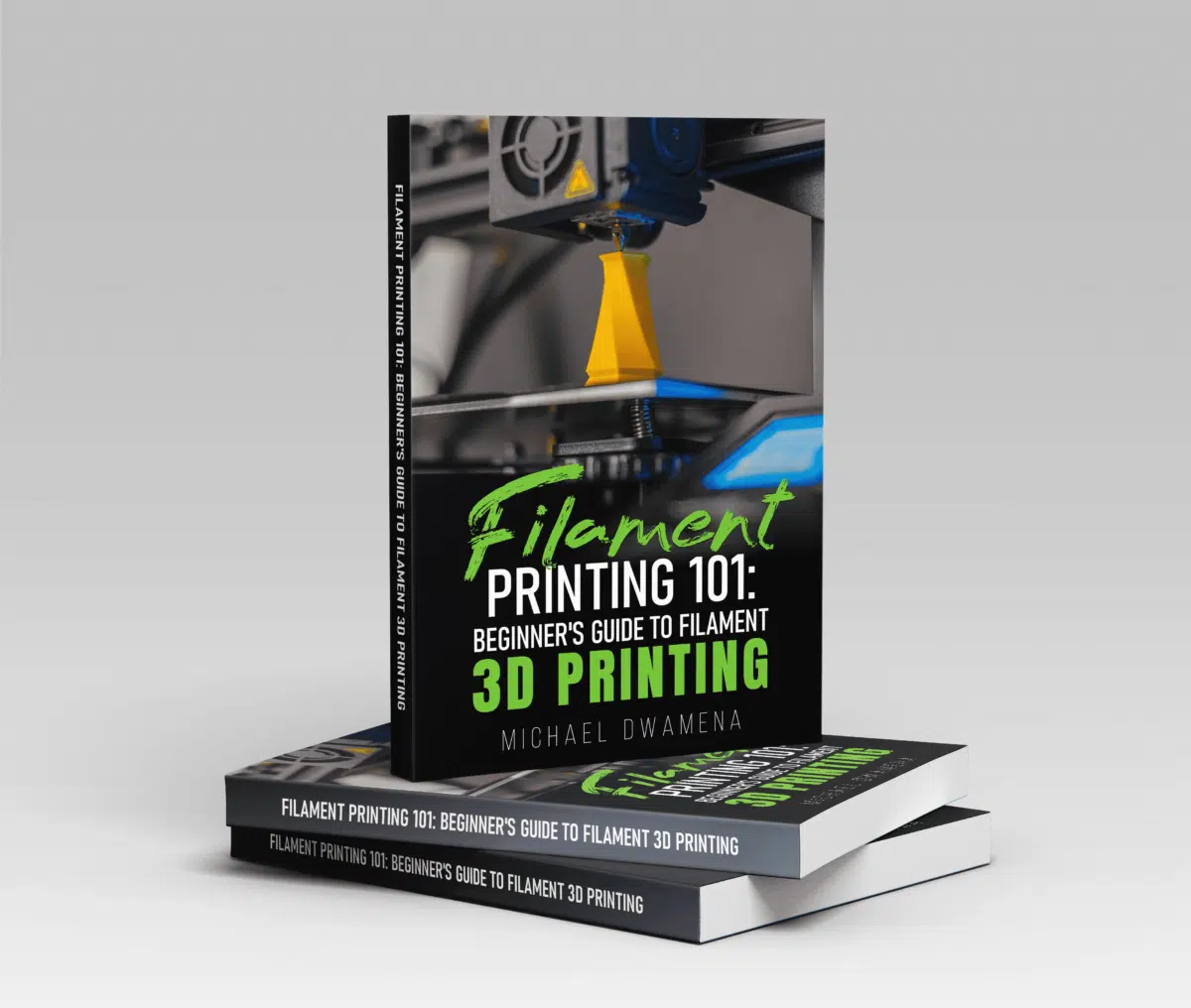The first step to creating unique metal objects is creating one-of-a-kind molds.
There are various ways to achieve this purpose, but 3D printing resin for molds is a sure way to guarantee that nobody can use your designs.
You can 3D print wax resin for a mold by following the steps below. You can use the same steps to print TPU and other types of filament.
- Design your mold in a CAD program.
- Slice the mold.
- Choose the printing material.
- Set printing parameters.
- Print your mold.
How To 3D Print Resin For Molds
In today’s world, 3D printing comes as an alternative to injection molding or carving for creating wax or resin casts.
The guide below can help you 3D print wax resin molds for metal casting or TPU filament molds for silicone or resin casting.
1. Design Your Mold
To begin manufacturing molds, you should start by designing them in a computer-aided design (CAD) program. This enables you to prepare the models for 3D printing with little effort.
There are numerous CAD software types available, including specific programs for designing industry, hobby, jewelry, and dentistry molds.
Choosing a program developed for designing the specific types of molds you need (e.g. for metalwork such as jewelry making or resin casting) can be wise if you want to cut off learning time. This type of software typically includes pre-made patterns that you can modify to fit your project.
Another way to design molds for 3D printing if you don’t have deep design skills is by reverse engineering an existing part.
This technique involves scanning a 3D mold and uploading it to your CAD software.
- Our new Filament Printing 101 Course is just for you! Lean how to create perfect professional prints without all the hassle.
- Don't let common mistakes hold you back, click the link to learn more and get ahead now!
Once you have an initial digital file, you can produce a prototype to see if it fits your needs, modify it for various purposes, or add new design elements to make it unique.
No matter what kind of pattern or mold you want to make, it is recommended to start with a solid block (100% infill) that is larger than the desired size of your mold. This block will act as a support and create your mold’s walls.
Now, design the object you want to make on a 0% infill setting. This will create a negative mold, or the hollow part of your cast.
Combine the solid block and the object to create the casting design.
2. Slice The Mold
Slicing allows you to transform the CAD design into a set of instructions your 3D printer can understand.
For this step, you have to use a specific slicing software. Depending on your experience, you can opt for open-source software such as Ultimaker’s Cura, or a licensed product like Simplify3D.
The main difference between open-source and licensed programs is that the latter is heavily audited and the risk of malware or viruses is considerably diminished.
Licensed software is also typically easier to use compared with open-source programs that are more developer-focused.
Regardless of the type of slicing software you use, here’s how to slice your object:
- Add your 3D printer to the slicing program if you haven’t done so already. In most slicing programs, you can find an Add Printer setting under the Printer Preferences menu.
- Save your CAD design as an STL file – this option is present in CAD software settings, or you can choose STL from the Save As drop-down list when saving the file. Some programs, such as Fusion 360, allow you to export the STL file directly into a slicer. Otherwise, save it locally on your computer.
- If your CAD software doesn’t export models to the slicer program, open the slicer software and upload the STL file you have saved on your disc.
- The slicer software should now let you position the part onto the 3D printer bed. You can normally click on the part and adjust its position on the bed.
- Select the printing material from the drop-down list. Depending on the material you want to cast (metal or resin), you should select wax resin or TPU filament here.
- Adjust the layer height to 0.02mm.
- Once you’re done, click the slice button to have the STL file converted into a g-code file that your 3D printer can read.
3. Choose The Printing Material
Choosing the right printing material is essential for guaranteeing the success of your project. Typically, 3D printing resin for molds is done for metalwork.
Castings can be done for a wide range of projects, such as jewelry, bronze statuettes, dentistry work, industry parts made of metal, etc.
If instead, you want to make a mold for casting resin objects, the best material is TPU filament. TPU filament is flexible enough to allow for an effortless object extraction from the mold, while also giving the mold the desired durability.
4. Set Printing Parameters
As you can expect, each printing material requires different feed rates and temperatures. These parameters can differ from brand to brand, so read the instructions coming with your wax resin or TPU filament to set the 3D printer.
A thing to keep in mind is that setting the printer parameters exactly as instructed by the filament brand may not create a watertight print – which is essential regardless of the material you want to pour into the mold.
To ensure water tightness and prevent making a mess, it is recommended to set the printer a little hotter (about 9°F/5°C more than the recommended printing temperature) and also turn up the flow rate a bit. The purpose is to squish together the layers, preventing unwanted holes or layer separation.
Also know that you should set the layer infill to 100%. This option can help you print a solid cast that can resist wear and tear. Especially if you’re making the mold for casting resin, remember that you’ll have to pull and twist the mold to get the casting out, so you want flexibility and strength all in one.
5. Print Your Mold
You can now print the mold in the highest possible resolution.
Choosing a high resolution for mold printing diminishes post-production work. This is particularly important if you’re printing TPU filament, which is difficult to sand and smooth out.
Depending on the printing material, decide before hitting the start button whether you need additional bed adhesion.
Benefits of Using 3D Printing for Resin Mold Making
3D-printed molds are slowly replacing carving and injection molds, and for good reasons. Here are some of their benefits.
1. Ability To Create Complex Shapes
One of the main advantages of 3D printing vs. injection molding is the variety of high-detailed shapes and structures that you can create.
CAD programs allow you to design complex geometries and achieve structures that are simply not possible or very difficult to create with other molding techniques.
This is an important advantage when creating molds for artwork or jewelry, for example, but also if you want to create unique prototypes of any kind.
2. Unique, Custom Designs
As explained above, you don’t need advanced CAD skills to create a 3D mold object. If you have little experience, you can scan an existing mold and use it in CAD as a prototype.
However, you don’t have to copy the original design. Starting from the premade base, you can customize your design until it is unique.
Whether you’re making cast objects for a hobby, as a side gig, or as full-time work, presenting your friends or customers with unique designs can give you a competitive edge.
3. More Cost-Effective Production
Compared to injection molding and even carving, 3D printing molds are cheaper.
That’s because injection molding machines are very expensive, whereas carving takes up a lot of work. To recuperate costs and time, companies increase mold-making prices.
With a 3D printer, on the other hand, you can design and print the molds yourself.
An entry-level machine won’t set you back more than a couple of hundred bucks. By comparison, injection molding machines can cost thousands of dollars.
4. Ability To Use Molds Faster
Unless you have the desire to spend a fortune on an injection molding machine, you’ll have to hire a third party to print your mold.
Even though injection molding machines can make a mold much faster than a 3D printer, chances are you won’t be the sole customer of the mold-making company. Waiting times typically vary from eight to ten weeks on average, but a complex design could take more than that.
With your own 3D printer, you can have the mold ready to use in two to three days tops, considering the design, printing, and curing time.
5. Easy To Make Amendments
When 3D printing resin for molds for the first time, there are high chances that the prototype won’t look exactly as you want.
Luckily, all you need to do if you aren’t happy with your masterpiece is to adjust the STL file and print the mold again.
6. Unparalleled Versatility
Generally, 3D printing molds are used for resin objects or metalwork. However, TPU and wax resin are not the only filament types, and there is no limit of the types of molds you can create.
If you want to make silicone products, for instance, you can 3D print silicone molds. Both PLA and ABS filaments work wonderfully for the purpose.
PLA, PP, PET, PET-G, and even co-polyester filaments are also suitable for making food-grade molds. If you rule out PET, nylon, and PLA, but use HIPS, ABS, or PEI instead, your food-grade molds will even be dishwasher friendly.
Thus, whatever project you have in mind, there is a 3D printing material suitable for your mold.
Frequently Asked Questions
What resin can you use for molds?
Epoxy resin is the most popular resin type poured into 3D-printed TPU molds. This is a versatile and tough material suitable for all sorts of custom jewelry, décor, figurines, and more.
If instead you’re a metalworker and wonder what resin to use to 3D print your molds, the answer is wax resin or castable filament.
Is 3D printing resin toxic to touch?
Liquid 3D printing resins are toxic to the touch and a serious safety hazard as long as they remain uncured. For this reason, you should always wear protective equipment, including gloves, goggles, and a respirator, when handling the products before printing.
These resins typically become safe to touch after printing, once they are cured. However, you should always read the label and follow the manufacturer’s instructions in regard to the handling of both uncured and cured resins.
Final Thoughts
No matter what type of molds you need, creating and 3D printing casts can be cheaper and faster compared to traditional methods.
We hope this guide can help you design and 3D print resin for metal work casts as well as make TPU, ABS, PLA, and other types of molds.




